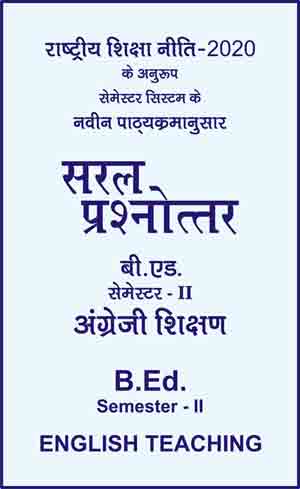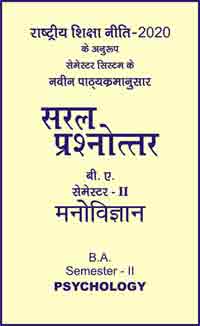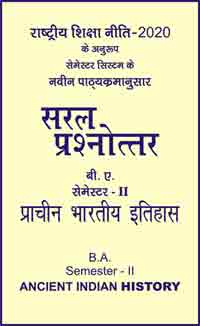|
बी एड - एम एड >> बीएड सेमेस्टर-2 अंग्रेजी शिक्षण बीएड सेमेस्टर-2 अंग्रेजी शिक्षणसरल प्रश्नोत्तर समूह
|
5 पाठक हैं |
||||||
बीएड सेमेस्टर-2 अंग्रेजी शिक्षण - सरल प्रश्नोत्तर
Chapter 1 - Development of English as a Discipline with Historical Perspective, its Role and Position in the Indian School Curriculum
Question- Enumerate the nature of English language.
Ans.
It is very difficult to explain the nature of language because its origin can not be determined. But there are some points which make efforts to clear its nature. These are described as :-
(i) Language is Learnt :- Language is learnt rather than an automatic process. An infant does not know any language. He has to learn it over a long period of time. He is exposed to sounds around him by his relatives. He begins learning of language by making various isolated sounds. Finally he becomes able to create babbling sound into the speech sounds. This is done by his own imitation. Then he learns the language suggested by local influence. Thus language is learnt by him.
(ii) Language is System :- Language is just like our body. As our body is a complex of various organs like hands, heart, eyes, ears, lungs, liver etc. These organs are inter-connected and work in co-ordination. Similarly, language is a system of various components like letter, words, sentences, sounds etc. These components are further interlinked like body organs and structured the whole which is language.
(iii) Language is Speech :- Language is speech and is distinct from the signs, gestures and sounds produced by animals to convey a particular feeling. It restricts itself to recognised expression and communication to or from human beings by means of speech and hearing. This communication passes through a man to another man by means of speech and hearing. Speech, therefore, is language. Speech is actually sounds produced by a man and recognised or understood by another people.
(iv) Operation of Language :- As language is an interaction between people therefore its operations are necessary.
There should be a corresponding situation for the language to operate upon. It is a conventional arrangement between the speaker and the listener. It is S-R interaction which may be indicated as—
Stimulus <---------------------------> Response
In a language, first of all, S transmits a message which is weaved by arrangement of word units. This message is received by R and translated giving a recognised meaning. R reacts to the message. It leads to conversation.
(v) Language is a System of Symbols :- A symbol is used to represent something. Symbols are used widely in our daily life. For example, red cross shows danger, V symbol means victory, up pointer finger in cricket match shows batsman out etc. Language is also a system of symbols. In the field of language, the symbols are words. Language is said effective when both the speaker and listener, writer and reader, could understand the symbols. Words which have sound have some meaning. So these symbols of language determines the objectivity of a language.
(vi) Language is Symbolic as well as Vocal :- The word language is derived from the Latin word 'Lingua' which means tongue. Language primarily is a speech. Writing is graphical representation of speech. There are many languages which are only in spoken form. They don’t have any written form.
(vii) Language is Arbitrary :- There is no necessary relation between the word and the object it stands for. For example, a set of printed pages and bound together in a cover is called as “Book” but it is often called Pustak or Kitab in Hindi and Urdu language respectively. None of these words is better be related than other to the reality of the book.
(viii) Language is Living :- A language undergoes a continuous and un-noticed change for its refinement. It responds to the demands and requirements of the group that it represents. As the human utterances become complex and varied, a language to be living must move with the group, should be alive to their needs and aspirations. In this process of change and growth, language acquires new shape, new approach, new significance and new application. In this way, language remains alive.
(ix) Language is Culture :- Every language is the product of a particular culture. It is significant for that culture only. Therefore, there are no exactly equal words in any two languages. In short, languages are different because cultures are different.
(x) Language and Society :- It is also said that language is one of the most important and characteristic forms of human behaviour. It helps man to express himself in a variety of new and different kinds of situations. In turn, society generates words and idioms by conventionalising them in a variety of complex contexts. In this way, the language and society both are mutually inclusive and dependent.
|
|||||













